Import My Inventory
Contents of this Topic: ShowHide
Overview
This topic discusses the product (inventory)
import process, although several other kinds of data can be imported through
the Import Data screen, such
as customer, or supplier records. Product cost, weight and price information
can be imported via this screen as well.
Data can be imported from a tab or comma-delimited
text file. Importing data from an MS Access database is no longer supported.
When importing data from a text file, if
the data contains commas, the file should be saved as a tab-delimited
file, not as a .csv file.
Quotes should not be present in text files,
regardless of whether it is a csv or tab-delimited file, or you will encounter
errors.
To access this screen, go to one of the
following program locations:
Main
Menu>Manage My Inventory>Import My Inventory - File
Main
Menu>Manage My Inventory>Import Cost, Price & Weight
Main
Menu>Manage My Inventory>Import My Suppliers
Main
Menu>Manage My Customers>Import My Customers - File
You are lead through the steps to import
the various types of data by a series of screens. Depending on the type
of data being imported, fields on the screens change. Refer to the specific
Knowledge Base topic for the
type of data being imported for more details.
Best Practice
Before importing data into the store file, make a backup copy in case
you need to back out the changes.
Description of the screens
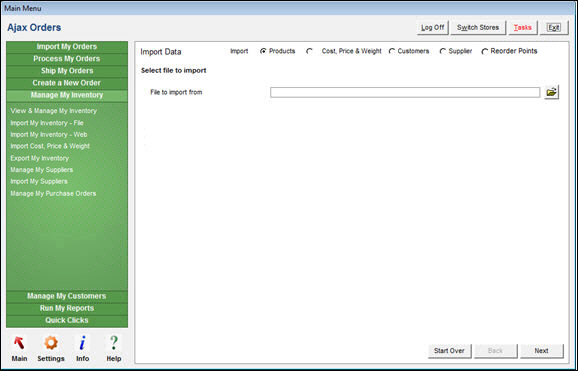
Import Inventory
screen: Select File to Import tab
Select File to Import tab
Import Radio
- Products
is selected by default
File to import from (text file)
- enter the path to the file containing the
product information
- the program displays up to 50 fields in the
file and the first 100 records at the bottom of the screen
Folder
- select this to navigate to the location of
the file containing the product information
Start Over
- clears the value in File
to import from or
returns to the Select File
to Import tab
Next
- select this when ready to proceed to the Import Options tab
Import Options tab
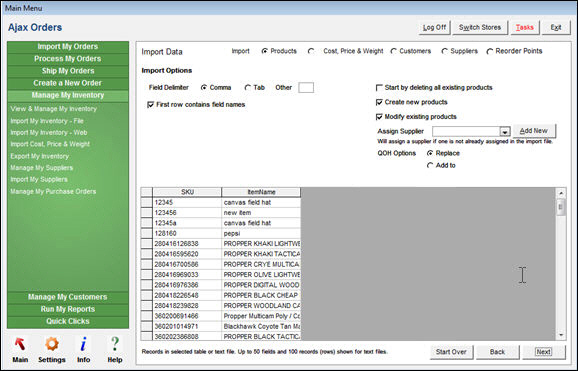
Import Inventory screen:
Import Options tab
Field Delimiter
Comma
Tab
Other
First Row Contains Field Names
Start By Deleting All Existing Products
- select this to delete all existing product
records in the Inventory table
before importing the data from the input file
- if this is not selected, products which do
not already exist are appended to the Inventory
table
Create New Products
- select this to create inventory records for
products which do not currently exist (based on the SKU)
- if this is not selected, existing product
records may be modified, but no new product records are added
Modify New Products
- select this to replace information in existing
product records with information from the input file (based on the
SKU)
- if this is not selected, new product records
may be added, but existing product records are not modified
Assign Supplier
- select a supplier to assign to product records
that do not already contain a Supplier ID or Supplier Name value
- this supplier automatically becomes the Primary
Supplier of the product
Add New
- select this to add a new supplier record
Data in Text File
- this refers to the grid at the bottom of the
screen which displays up to fifty fields and the first one hundred
records of data in the input file
Start Over
- clears the information already entered and
returns to the Select File to Import
tab
Back
- returns to the previous tab
Next
- select this button when ready to proceed to
the Inventory Fields tab
Inventory Fields tab 1
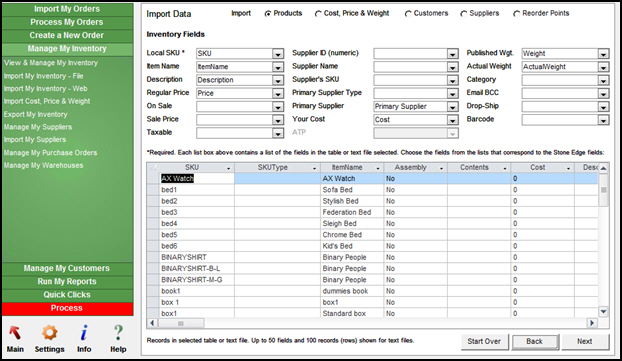
Import
My Inventory - File: Inventory Fields tab1
- map the fields in the input file to their
counterparts in Monsoon
Order Manager
- Local SKU is the only required field
| Local SKU |
Supplier ID |
Published Weight |
| Item Name |
Supplier Name |
Actual Weight |
| Description |
Supplier's SKU |
Category |
| Regular Price |
Primary Supplier Type |
Location |
| On Sale |
Primary Supplier |
Email BCC |
| Sale Price |
Your Cost |
Drop-Ship |
| Taxable |
ATP (Inactive) |
Barcode |
Data in Text File
- this section of the screen displays up to
fifty fields and the first one hundred records of data in the input
file
Start Over
- clears the information already entered and
returns to the Select File to Import
tab
Back
- returns to the previous tab
Next
- select this when ready to proceed to the second
page of the Inventory Fields
Inventory Fields tab 2
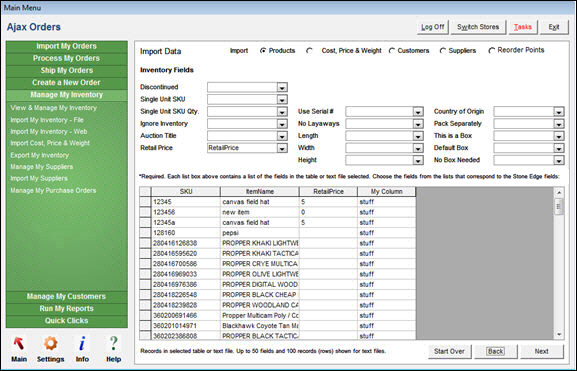
Import
My Inventory - File: Inventory Fields tab 2
- continue mapping fields in the input file
to those in Monsoon
Order Manager
| Discontinued |
No Layaways |
Default Box |
| Single Unit SKU |
Length |
No Box Needed |
Single Unit SKU Qty. |
Width |
|
| Ignore Inventory |
Height |
|
| Auction Title |
Country of Origin* |
|
| Retail Price |
Pack Separately |
|
| Use Serial # |
This is a Box |
|
* this must be a two-letter abbreviation
for the country in which the product was produced and is used in customs
forms
Data in Text File
- the grid at the bottom of the page displays
up to fifty fields and the first one hundred records of data in the
input file
Start Over Button
- clears the information already entered and
returns to the Select File to Import
tab
Back
- returns to the previous tab
Next
- select this when ready to proceed to the first
page of the Custom Fields
tab, if custom inventory fields are defined
Custom Fields tab 1
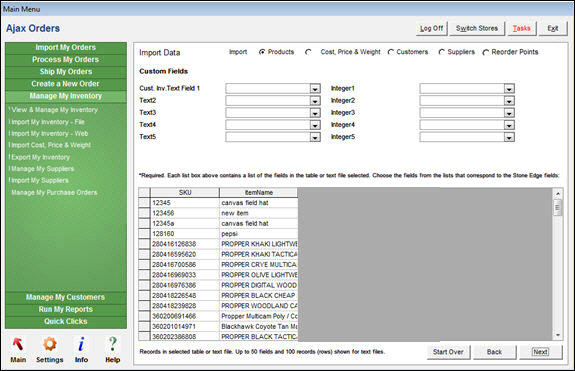
Import My Inventory -
File: Custom Fields tab 1
- map fields in the input file to any custom
inventory text or integer fields defined in Monsoon
Order Manager
- this tab is not visible if custom inventory
fields are not defined
Data in Text File
- this grid at the bottom of the screen displays
up to fifty fields and the first one hundred records of data in the
input file
Start Over
- clears the information already entered and
returns to the Select File to Import
tab
Back
- returns to the previous tab
Next
- select this when ready to proceed to the second
tab of Custom Fields, if custom
inventory fields are defined
- map fields in the input file to any custom
inventory text or integer fields defined in Monsoon
Order Manager
Custom Fields tab 2
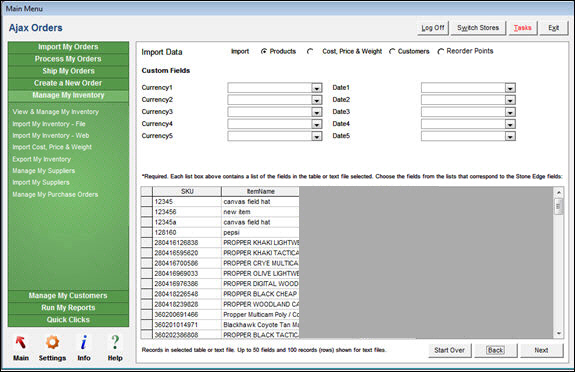
Import My Inventory -
File: Custom Fields tab 2
- map fields in the input file to any custom
inventory currency or date fields defined in Monsoon
Order Manager
- this tab is not visible if custom inventory
fields have not been defined
Data in Text File
- the grid at the bottom of this screen displays
up to fifty fields and the first one hundred records of data in the
input file
Start Over
- clears the information already entered and
returns to the Select File to Import
tab
Back
- returns to the previous tab
Next
- select this when ready to proceed to the Web Fields tab
Web Fields tab
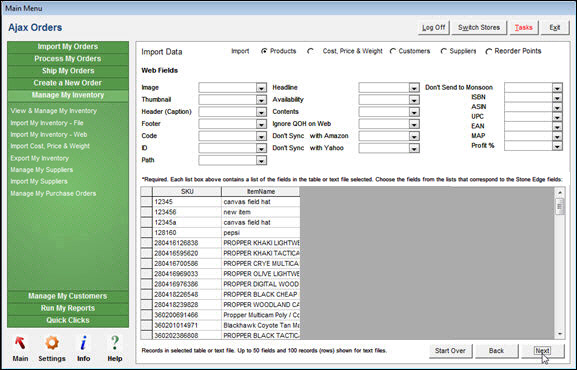
Import Inventory screen:
Web Fields tab
- map fields in the input file to fields in
Monsoon
Order Manager
- the fields on this screen may not apply to
your shopping cart system
- refer to the Inventory
Knowledge Base topic for more details
| Image |
Headline |
Don't Send to Monsoon |
| Thumbnail |
Availability |
ISBN |
| Header |
Contents |
ASIN |
| Footer |
Ignore ATP on Web |
UPC |
| Code |
Don't Sync with Amazon |
EAN |
| ID |
Don't Sync with Yahoo |
MAP |
| Path |
|
Profit % |
Data in Text File
- the grid at the bottom of the screen displays
up to fifty fields and the first one hundred records of data in the
input file
Start Over
- clears the information already entered and
returns to the Select File to Import
tab
Back
- returns to the previous tab
Next
- select this when ready to proceed to the Pricing Fields tab
Pricing Fields tab
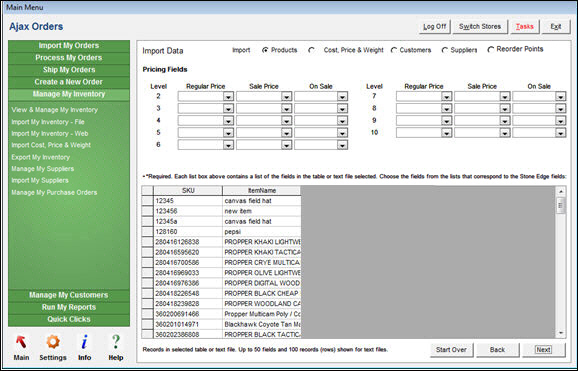
Import
Inventory screen: Pricing Fields tab
- map fields in the input file to fields in
Monsoon
Order Manager
- the fields on this screen apply to multi-level
pricing
- refer to the Knowledge Base topic Price
Levels for more information
Data in Text File
- the grid at the bottom of the screen displays
up to fifty fields and the first one hundred records of data in the
input file
Start Over
- clears the information already entered and
returns to the Select File to Import
tab
Back
- returns to the previous tab
Next
- select this when ready to proceed to the Finish and Import tab
Finish and Import Tab
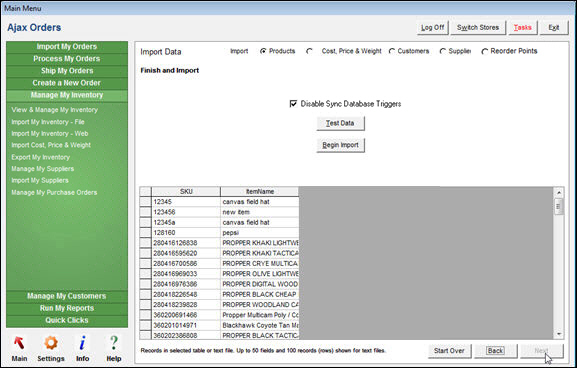
Import Data screen: Finish
and Import tab
Disable Sync Database Triggers
- this is selected by default and prevents individual
product sync messages from being generated when initially setting
up the system (handled by provisioning event instead)
- if you are importing product information after
production processing commenced, clear this box so the appropriate
Sync Manager messages are created and sent to the Fulfillment Manager
Test Data
- select this to have the program check for
errors before starting the import process
Begin Import
- select this to start the import process
Start Over
- clears the information already entered and
returns to the Select File to Import
tab
Back Button
- returns to the previous tab
Additional information
Created:
6/15/12
Revised:
8/10/15
Published:
08/19/15










